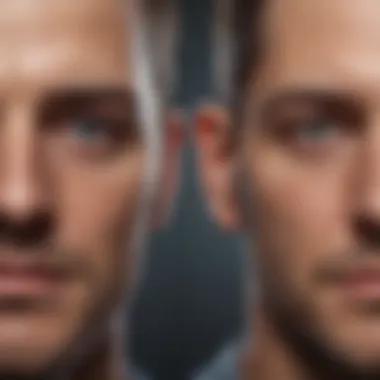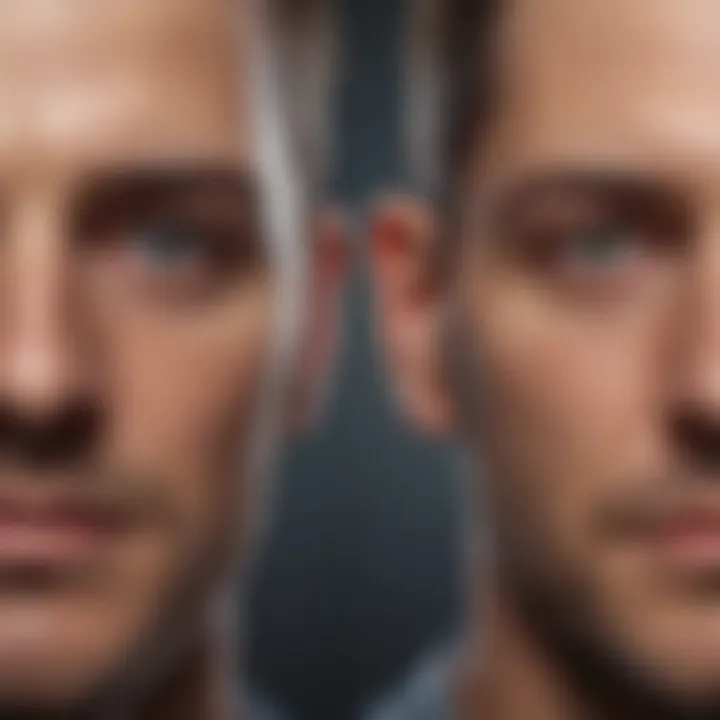Understanding Diplopia: Causes and Implications


Intro
Diplopia, commonly known as double vision, is a visual disturbance that causes an individual to see two images of a single object. This phenomenon can be particularly pronounced when attempting to focus on distant objects. Understanding diplopia is crucial, as it impacts not only visual perception but also everyday functioning. For students, researchers, educators, and professionals, it is imperative to grasp the causes and implications of this condition to foster better visual health. It effects can range from minor inconvenience to significant disruption in one's ability to work and engage in daily activities.
Research Highlights
Overview of Key Findings
Recent studies indicate that diplopia can stem from various underlying conditions, including neurological disorders, ocular misalignment, and systemic diseases like diabetes. Research has shown that the condition can manifest suddenly or develop gradually, influenced by the age and health status of the individual. In a majority of cases, diplopia is not merely a visual anomaly but a symptom that could indicate underlying health issues requiring comprehensive evaluation.
Significance of the Research
The significance of this research cannot be overstated. By examining the causes and implications of diplopia, we can understand the broader context of visual health. In an era where screen time is at an all-time high, recognizing the signs and symptoms of diplopia is essential. Enhanced awareness allows for timely diagnosis and treatment, thereby improving the quality of life for affected individuals.
"Double vision can significantly affect one’s ability to engage in safe driving, job performance, and overall quality of life."
Original Research Articles
Recent articles have provided new insights into diplopia, focusing on its impact on daily life. One such article outlines the various types of diplopia, including horizontal and vertical double vision, discussing their implications on both personal and professional levels. Author contributions have emphasized comprehensive evaluation techniques and the importance of personalized treatment plans.
Overall, a deeper understanding of diplopia encourages not only better awareness but also advancements in training for healthcare professionals.
Diplopia: An Overview
Diplopia, often simply called double vision, can significantly impact an individual's daily life. Understanding this condition is crucial for effective diagnosis and management. The implications of experiencing diplopia extend beyond mere visual disturbances; they often affect emotional well-being and quality of life. This overview aims to establish a foundation for understanding diplopia's nature and the challenges it presents.
Definition and Types
Diplopia is defined as the perception of two images of a single object. This condition can be classified into two distinct types: monocular and binocular diplopia.
- Monocular Diplopia: This type occurs when double vision persists in one eye. Even if the unaffected eye is closed, the double vision remains. Often, this form of diplopia relates to issues such as corneal irregularities, lens opacities, or retinal diseases.
- Binocular Diplopia: In contrast, binocular diplopia is seen only when both eyes are open. This type indicates a misalignment of the eyes, which may arise from conditions affecting the eye muscles or nerves. It usually resolves when one eye is covered, making it closely related to issues of ocular alignment and coordination.
Common Symptoms
The symptoms of diplopia can differ based on its type and underlying causes. Common experiences include:
- Double images: The primary symptom, where objects appear to be duplicated.
- Varied appearance: The second image may be shifted laterally, vertically, or diagonally.
- Blurry vision: There may be a sense of fuzziness associated with the doubled images, making it difficult to focus.
- Eye strain or discomfort: Many individuals report fatigue or discomfort in their eyes due to the strain of attempting to focus correctly.
- Headaches: Tension caused by the visual confusion can lead to recurring headaches.
Understanding these symptoms is essential for timely assessment and intervention. Proper recognition can lead to a more precise diagnosis and a targeted treatment approach.
Physiology of Vision
Understanding the physiology of vision is crucial in the context of diplopia, or double vision. This section delves into how the eye functions and how the brain processes visual information. A comprehension of these processes sheds light on the nature of diplopia. When the systems responsible for sight do not work in harmony, it can lead to significant visual issues, including seeing double. This section will provide clarity on these essential physiological mechanisms.
The Eye Structure
The structure of the eye is intricate and designed to work cohesively to produce clear vision. The key components of the eye include:
- Cornea: the transparent front layer that helps focus light.
- Lens: this flexibly adjusts to focus light properly on the retina.
- Retina: contains light-sensitive cells that convert light into signals.
- Optic Nerve: transmits visual information from the retina to the brain.
Each part of the eye plays a distinct role in the visual process. For example, if the alignment of these structures is disrupted due to conditions affecting the muscles around the eye, one may experience diplopia. This misalignment can occur for various reasons, including trauma or neurological disorders. A clear understanding of the ocular anatomy and its functions is essential to grasp why and how diplopia manifests.
Visual Processing in the Brain
The processing of visual information does not cease at the retina; it continues in the brain. The occipital lobe, located at the back of the brain, is primarily responsible for processing visual input. Here, the brain interprets signals coming from the optic nerve. The brain compares information from both eyes to create a single, cohesive image.
In cases of diplopia, this coordination may fail, and the brain struggles to merge the visual input. Additionally, other areas of the brain, such as the parietal region, help with spatial awareness and depth perception, which can also be affected by this condition.


Understanding the physiology of vision is vital in addressing diplopia, offering insights into how various disorders can disrupt our visual experience.
Causes of Diplopia
Understanding the causes of diplopia is essential for identifying the proper treatment and management of this visual condition. Diplopia can stem from various origins, and recognizing these can greatly assist healthcare providers and researchers in understanding its implications on individuals’ lives. The different causes can be grouped into categories such as neurological conditions, ocular disorders, and systemic health issues. Each category highlights distinct mechanisms that lead to double vision, emphasizing the interdisciplinary approach required for effective diagnosis and treatment.
Neurological Conditions
Neurological conditions play a significant role in the emergence of diplopia. Commonly, conditions such as multiple sclerosis, myasthenia gravis, and stroke affect the central nervous system, leading to disruptions in the way the brain processes visual information.
- Multiple Sclerosis: This autoimmune disorder can result in demyelination of the optic nerve, impacting vision and causing diplopia.
- Myasthenia Gravis: A chronic autoimmune disorder that affects the neuromuscular junction. Patients may experience fluctuating muscle weakness, which can involve the extraocular muscles that control eye movement, leading to diplopia.
- Stroke: Interruption of blood flow to the brain may damage areas responsible for vision and coordination, leading to one or both eyes misaligning.
The diagnosis of diplopia linked to neurological conditions often requires advanced imaging, such as MRI scans. This enables clinicians to see structural changes in the brain that might be causing visual disturbances.
Ocular Disorders
Ocular disorders are another important source of diplopia. These conditions can directly affect the eye's alignment or the functioning of the muscles responsible for movement.
- Strabismus: Misalignment of the eyes, where one eye turns inward, outward, upward, or downward. This is particularly prevalent in children but can also develop later in life.
- Cataracts: While primarily impacting clarity of vision, cataracts can also cause problems with perception and sometimes lead to double vision.
- Pterygium: A growth of tissue on the eye which can distort light entering the eye and create double vision.
Identifying the precise ocular issue through comprehensive eye exams is critical. Further, conditions like strabismus require intervention, as they can result in long-term visual problems if not addressed.
Systemic Health Issues
Lastly, systemic health issues can contribute to diplopia, particularly conditions that affect overall health or specific bodily systems. Diabetes, for example, leads to complications such as diabetic neuropathy, affecting the nerves that control eye function.
- Diabetes Mellitus: Can cause vascular changes that affect the cranial nerves responsible for eye movement, leading to diplopia.
- Thyroid Disorders: Graves' disease can lead to inflammation and swelling of the eye muscles, causing diplopia due to misalignment.
- Hypertension: High blood pressure can impact blood flow and may induce temporary visual changes.
In summary, the causes of diplopia are multifaceted, involving neurological, ocular, and systemic health elements. Awareness of these diverse sources is crucial for individuals experiencing symptoms. A thorough diagnostic approach is essential, as the underlying cause directly influences treatment options and patient outcomes.
"Identifying the root causes of diplopia can be vital for effective management and improving quality of life."
Diagnosis of Diplopia
Diagnosing diplopia is a critical step in understanding this visual condition, which can significantly affect one’s quality of life. The importance of accurate diagnosis cannot be overstated; it not only helps identify the underlying cause, but also enables effective management and treatment. Recognizing the type and source of double vision is essential for tailoring the approach to each patient, allowing for more personalized care.
Clinical Assessment Techniques
Several clinical assessment techniques are used by healthcare providers to diagnose diplopia effectively. The first step typically involves a detailed patient history. Understanding the onset of symptoms and any associated conditions can provide valuable clues.
Next, healthcare professionals often conduct a comprehensive eye examination. This may include tests for visual acuity, eye movement, and alignment. These assessments are crucial in determining whether the diplopia is monocular, meaning it persists even if one eye is closed, or binocular, which may resolve when one eye is shut.
Some common techniques are:
- Cover Test: A simple yet effective method to evaluate how the eyes work together.
- Ocular Motility Testing: This examines the range of movement in each eye and may reveal muscle dysfunction or cranial nerve palsies.
- Refraction Test: This checks for refractive errors which may contribute to double vision.
These assessments help to build a preliminary picture of the patient’s visual function, guiding further investigations as necessary.
Advanced Imaging Technologies
Advanced imaging technologies further enhance the diagnostic capabilities for diplopia. Techniques such as Magnetic Resonance Imaging (MRI) and Computed Tomography (CT) scans can visualize the anatomy of the eye and surrounding structures, helping to identify more elusive causes of diplopia, such as tumors, lesions, or structural abnormalities.
"Utilizing advanced imaging technologies can provide insights that are not visible during standard examination."
Other imaging techniques that may be employed include:
- Ultrasound: Useful for evaluating the eye's internal structures and detecting any abnormalities.
- Optical Coherence Tomography (OCT): This non-invasive imaging technique allows for high-resolution images of the retina, helping to understand any retinal issues contributing to the visual symptoms.


Early and precise diagnosis of diplopia not only aids in effective treatment but also plays a vital role in preventing possible complications stemming from underlying conditions. Awareness and understanding of the diagnostic process can empower patients to seek timely medical help, potentially leading to better outcomes.
Impact of Diplopia on Daily Life
The impact of diplopia extends beyond mere visual distortion. It permeates various aspects of daily life, shaping experiences, interactions, and overall well-being. People who experience double vision often face unique challenges that can affect their independence and quality of life. Understanding these implications can raise awareness and foster empathy, necessary for finding effective solutions and support systems.
Challenges in Daily Activities
Diplopia presents significant obstacles in routine activities. As the phenomenon disrupts visual clarity, tasks that require precise visual coordination become difficult.
- Reading: Individuals with diplopia struggle with text comprehension. The words may blur together or double, making it challenging to focus.
- Navigation: Choosing safe paths can be problematic. Double vision leads to uncertainty about distances and spatial awareness, increasing the risk of falls.
- Driving: Operating a vehicle with diplopia can pose dangerous situations. The difficulty in judging distances may result in erratic driving behavior or accidents.
The effects can lead to frustration and anxiety, impacting emotional health. Individuals might feel isolated from social engagements due to fear of embarrassment or injury.
Implications for Professional Life
In professional settings, the ramifications of diplopia may be even more pronounced. Disruptions to daily work processes can hinder productivity and performance. Consider the following:
- Job Performance: Certain jobs require acute visual acuity for quality control and operation. Diplopia can impair the ability to execute tasks, causing mistakes and lower efficiency.
- Career Choices: Some individuals may need to reconsider their chosen profession. Fields like driving, aviation, and even healthcare could be out of reach due to the safety concerns related to impaired vision.
- Social Interactions: Workplace dynamics could suffer. Individuals experiencing double vision may find it hard to participate in conversations or gauge others’ reactions, hindering teamwork.
The psychological toll is evident. Navigating professional challenges compounded by physical barriers often leads to stress, making it vital to seek appropriate accommodations and treatment options.
Treatment Options for Diplopia
Understanding how to treat diplopia is essential in managing this complex condition. A range of treatment strategies exists, each tailored to the underlying causes and the individual's specific needs. These options include conservative management strategies, surgical interventions, and vision therapy approaches. Each method comes with its own set of benefits and considerations. Exploring these treatment avenues gives a clearer picture of how to address and alleviate the challenges posed by diplopia in daily life and professional settings.
Conservative Management Strategies
Conservative management strategies often serve as the first line of defense in treating diplopia. These methods aim to reduce symptoms without invasive procedures. Common strategies include:
- Prism Lenses: These glasses are designed to realign the visual input from each eye. They can help correct the double vision effectively for some individuals.
- Patch Therapy: Covering one eye temporarily helps the brain reconcile the images it receives. This method is particularly useful in cases where one eye is dominant.
- Medication: In some instances, addressing the underlying condition causing diplopia may include medication. For example, anti-inflammatory drugs or steroids can manage inflammation affecting the eye muscles.
These conservative approaches can be particularly effective when diplopia stems from conditions that may resolve. Moreover, patients often prefer non-invasive options as they are less risky and have shorter recovery times.
Surgical Interventions
When conservative strategies fail to yield satisfactory results, surgical interventions may be necessary. Surgery aims to correct misalignment of the eyes and restore proper function. Common surgical options include:
- Strabismus Surgery: This procedure involves adjusting the muscles around the eye to better align them. It’s often recommended for patients with significant muscle imbalances.
- Eye Muscle Recession or Resection: These specific surgeries either weaken or strengthen eye muscles directly.
- Botox Injections: In some cases, botulinum toxin injections can temporarily weaken specific muscles, allowing for better positioning and alignment.
Surgical interventions can dramatically improve quality of life, but they are not without risks. Potential complications include infection, prolonged recovery, or the need for additional surgeries. Hence, thorough assessment and patient education are crucial before proceeding.
Vision Therapy Approaches
Vision therapy is a comprehensive treatment option that involves a series of exercises tailored to improve visual skills and coordination. Unlike traditional therapies, vision therapy focuses on altering the visual processing in the brain. Common components include:
- Eye Exercises: Patients perform tasks designed to strengthen coordination between the eyes and improve focusing abilities.
- Computer-based Training: Technological tools can enhance visual skills through engaging and interactive exercises.
- Personalized Programs: Each program is customized based on the individual’s specific needs and goals, taking into account both the physical and cognitive aspects of vision.
Vision therapy may not offer immediate relief, as it requires commitment over time. However, its holistic approach can lead to significant breakthroughs in managing symptoms and improving visual function.
"Identifying the right treatment is not just about alleviating symptoms; it is also about restoring confidence and improving quality of life."
Prevention and Awareness
Understanding the risks associated with diplopia and taking preventive measures is essential for maintaining optimal eye health. Awareness of the factors that contribute to this condition can help individuals take early action and mitigate potential complications. Prioritizing eye care and being vigilant about changes in vision can lead to significant improvements in quality of life.
Eye Health Guidelines


Establishing a set of guidelines for eye health is crucial for everyone. These recommendations can help reduce the risks for various ocular conditions, including diplopia. Consider the following points:
- Nutrition: A diet rich in vitamins A, C, and E, along with omega-3 fatty acids, can promote eye health. Foods like carrots, leafy greens, nuts, and fish should be incorporated into one's diet.
- Eye Protection: Wearing sunglasses that block UV rays protects the eyes from harmful sun exposure. Similarly, using safety goggles during activities that could pose a risk to the eyes is important.
- Screen Time Management: Given the prevalence of screens in daily life, following the 20-20-20 rule can be beneficial. This rule suggests that after every 20 minutes of screen time, one should look at something 20 feet away for at least 20 seconds. This simple practice can help reduce eye strain and fatigue.
- Hydration: Staying adequately hydrated helps to maintain optimal eye moisture. Dehydration can lead to dryness and irritation, which may exacerbate visual problems.
Importance of Regular Check-ups
Regular eye examinations are fundamental in preventing diplopia and other visual impairments. These check-ups allow for early detection and intervention. The significance of continuous monitoring and adjustment of eye health cannot be understated:
- Early Detection: Many ocular issues develop gradually. Regular check-ups can help in identifying changes in vision before they become pronounced, allowing for timely treatment.
- Professional Guidance: An eye care professional can provide personalized advice based on an individual’s unique needs. This includes recommendations for corrective lenses or treatments that can alleviate symptoms of diplopia.
- Tracking Health Conditions: Individuals with systemic conditions, like diabetes or hypertension, require regular assessments. These conditions may lead to visual disturbances, making monitoring vital.
- Adaptations: A routine check-up can lead to updates in prescriptions or treatment plans as vision needs change over time. Staying proactive ensures that individuals are making the best choices for their eye health.
Regular check-ups empower individuals to take control of their eye health, catching potential problems before they escalate.
Future Directions in Research
The study of diplopia and its implications is an evolving field, attracting attention from both medical professionals and researchers. Understanding this condition is essential for improving treatment strategies and enhancing patient care. Future research must focus on uncovering the underlying mechanisms of diplopia, exploring innovative therapies, and leveraging modern technology to address the challenges faced by individuals suffering from double vision.
Continuous research in diplopia not only enhances our understanding but also develops practical solutions for those affected. Identifying new therapeutic approaches and improving existing methods can lead to more effective interventions. Therefore, researchers must prioritize collaboration across disciplines, combining insights from ophthalmology, neurology, and psychology.
Emerging Therapies
Emerging therapies for diplopia promise significant advancements in managing this condition. These therapies range from pharmacological solutions to novel rehabilitation techniques. For instance, new medications targeting neurological pathways may alleviate symptoms for some patients, especially those with diplopia stemming from neurological conditions.
Additionally, rehabilitation programs which focus on visual exercises and corrective lenses can address functional visual deficits. A recent focus in research has been on prism therapy, which uses specially designed glasses to align double images, helping patients regain proper binocular vision. The effectiveness of these therapies relies on individual assessments and customization to ensure suitability for the patient's specific needs.
Technological Innovations
Technological innovations are crucial for improving the understanding and treatment of diplopia. Advancements in imaging techniques, such as Optical Coherence Tomography, allow for detailed visualization of eye structures, enhancing diagnostic capabilities. Greater precision in diagnosis leads to tailored treatment approaches.
Telemedicine has also emerged as a vital tool for patient management, enabling remote consultations and follow-ups. This is especially beneficial for individuals in remote locations or with mobility issues. Mobile applications designed to monitor visual symptoms and treatment progress are being developed, providing real-time data to healthcare providers.
In summary, the future research directions in diplopia encompass a blend of emerging therapies and technological innovations, both vital for establishing better management practices and enhancing the quality of life for those affected by this condition. Continued exploration in these areas will lay the groundwork for breakthroughs that can reshape the understanding and treatment of diplopia.
Psychological and Social Impacts
Understanding the psychological and social impacts of diplopia is crucial. This vision condition can extend far beyond the simple physical experience of seeing double. It infiltrates into mental health, social interactions, and even the professional realm, leading to a need for comprehensive awareness and support systems.
Mental Health Concerns
People experiencing diplopia often face various mental health issues. The sensation of seeing double can be distressing and disorienting, contributing to anxiety and depression. Individuals may feel isolated as they grapple with processing their world differently. The stress from constant adjustments to distorted visuals can lead to heightened frustration and contribute to a sense of inadequacy when engaging in daily tasks.
For many, the fear of embarrassment in public can exacerbate these issues. There is often a feeling of helplessness, particularly when unable to drive or perform activities that require clear sight. Research indicates that untreated visual impairments, like diplopia, can result in a lower quality of life, leading to an increased risk of mental health concerns.
"Diplopia does not just affect vision; it profoundly influences emotional well-being and everyday function."
Social Stigma and Misunderstandings
Social stigma surrounding diplopia is a notable barrier. Those with this condition often face misconceptions from the wider public. Many people may not understand the nature of double vision or regard it as a trivial issue, leading to feelings of invalidation among sufferers. Such misunderstandings often prevent those affected from seeking necessary support.
In social settings, individuals with diplopia might avoid interactions due to fear of judgment. This can result in social withdrawal, leading to loneliness. Moreover, a lack of awareness about the condition can lead friends and family to misinterpret the behavior and challenges of someone experiencing diplopia. This scenario highlights the need for education to foster understanding and compassion within communities.
Addressing these psychological and social impacts is essential for improving the lives of individuals facing diplopia. Awareness campaigns and support groups can play a significant role in creating an inclusive society where those with double vision can thrive.
Ending
Diplopia, or double vision, presents a multifaceted challenge that extends beyond visual impairment. Understanding its complexities is crucial for timely diagnosis and effective management. Awareness of the condition's various causes allows for appropriate intervention, which can significantly improve quality of life. When individuals are well-informed, they can better navigate the hurdles of daily activities and professional responsibilities.
This article encapsulates the underlying causes of diplopia, including neurological conditions, ocular disorders, and systemic health issues. By shedding light on these factors, we aim to demystify the situation for patients and their families.
Key Elements to Consider:
- Impact on Daily Life: The implications of diplopia can pervade all aspects of life, affecting everything from driving to reading. Understanding this allows for the establishment of proper support systems.
- Mental Health Considerations: Psychological impacts, including anxiety and social stigma, deserve consideration. Addressing these can improve patient outcomes and reinforce mental well-being.
- Importance of Treatment and Prevention: Identifying available treatment options, such as vision therapy or surgical interventions, forms a core part of managing diplopia.
These elements highlight the necessity of recognizing diplopia as a serious condition, deserving of attention from healthcare providers, patients, and the broader community. The collective understanding and proactive engagement with this condition can foster a more supportive environment for those affected, driving improvements in both diagnosis and treatment.







